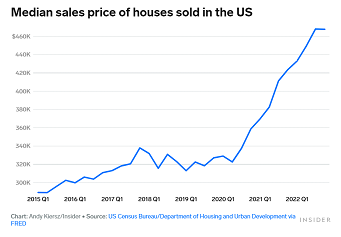WHO IS BUYING HOMES TODAY? THE CHANGING DEMOGRAPHICS OF TODAY’S HOMEBUYERS
- March 11, 2024
In recent years, the landscape of home buying has dramatically shifted. Various economic, social, and cultural factors have contributed to changing the demographics of today’s homebuyers. Whether you’re in the real estate industry, a prospective buyer, or simply someone interested in the current market trends, understanding these changes can provide valuable insights. In this blog post, we’ll delve into the evolving demographics of today’s homebuyers and discuss how these trends are shaping the real estate market.
Let’s begin by analyzing the profile of home buyers in 2023 (information provided by the NATIONAL ASSOCIATION OF REALTORS’ Profile of Home Buyers and Sellers):
Average household income: $107,000 versus $88,000 in 2022
Percent who paid cash: 20% of homebuyers paid all cash for their home versus only 13% in 2021.
Average downpayment for first-time buyers: 8%. This is the highest share since 1997 when the typical downpayment reached an all-time high of 9%
Average downpayment for repeat buyers: 19%. This is the highest share since 2005 when the typical downpayment reached 21%
Percent buying in suburbs: 47% versus 39% in 2022. This figure remains below the 50% peak reached in 2017-2021. The COVID pandemic unleashed a move to the suburbs and that trend seems to be coming to an end
Share of first-time buyers: 32%. This is an improvement versus the historic low of 26% a year earlier. However, this it still below the historic average of 38% seen since 1981
Age of buyers: The average age for first-time buyers was 35 while for repeat buyers it was 58. These are the second highest ages seen in the report
Demographic profile: 81% of buyers were White/Caucasian, down from 88% a year earlier. Ten percent of buyers were born outside the US (versus 8% in 2022). Minority buyers reached 19% and continue to grow. 7% of buyers were Hispanic/Latino, 7% Black/African-American, 6% Asian/Pacific Islander and 6% identified as other race
Household composition: 59% of buyers were married couples. This is the lowest share of married couples since 2010. Both single men and single women saw an increase. Single females represented 19% of all buyers and single males represented 10%. Additionally, 9% of buyers were unmarried couples. Multi-generational living remains popular with 14% of buyers purchasing a home that houses multiple generations. The share of buyers with children under the age of 18 dropped to the lowest level seen at 30% of all buyers only
Time to find a home: Buyers on average looked for a home for 10 weeks before finding the one. Buyers are using virtual tours and listings more than ever before
Buyer’s agent: 89% of buyers used an agent, versus 86% the year before
Reason for buying. For first-time buyers the main reason was a desire to own a home of their own
There are significant trends impacting home buyers. Among them, the most significant are:
The Rise of Millennial Homebuyers:
This generation has become a dominant force in the homebuying market. After years of being characterized by renting, millennials are now reaching an age where they are settling down, starting families, and becoming financially stable. Millennials are set to receive a windfall and inherit as much as $50 trillion in assets before 2044. Millennials are beginning to prioritize homeownership and this might have significant implications for the market. First, millennials plan to have fewer kids than previous generations. This trend is visible in today’s market as the share of buyers with kids in 2023 dropped to an all-time low while the average homebuying age remains near all-time highs. Likely, millennials will not require 3 or 4 bedrooms in their homes so expect to see a higher share of 1-2 bedrooms coming to market.
Changing Demographics:
There are several key trends to watch here. First, the share of single female buyers continues to increase as is now almost double that of single male buyers. Marketing to women has never been more relevant for real estate agents, home builders, and developers. Only 59% of buyers were married couples and unmarried couples also continue to gain a larger share of the market. Second, minorities continue to represent a larger share of the market and we expect this trend to continue.
Urban vs Suburban Shifts:
Homebuyers are returning to urban areas after the COVID pandemic sent them looking for affordable space in the suburbs. However, hybrid work allows more people to live further away from their offices and commute a few days per week. We expect the suburbs will continue to take an elevated share of the market. This is a contrast difference versus the pre-pandemic trends when most young adults had a clear preference for vibrant urban communities.
Technology:
Technology has significantly impacted the home buying process, influencing the demographics of homebuyers. Online platforms, virtual tours, and digital mortgage applications have made the process more accessible and appealing to younger, tech-savvy generations. This ease of access has enabled more first-time homebuyers to enter the market and has changed the way real estate transactions are conducted.
Investor Purchases:
The share of investor purchases had been on a clear growth trend, to the detriment of homebuyers. When investors purchase homes, they reduce the supply of homes available for sale which can lead to higher prices. This trend reversed in 2023 but if/when rates go lower, we expect investor activity will pick up significantly.
Financial Considerations:
Student loan debt and a fluctuating economy have played a crucial role in the demographics of homebuyers. Various alternatives including our INTRO Program, government-backed loans and HEI downpayment assistance funds are helping to alleviate these barriers and enable more individuals to achieve homeownership and financial freedom.
